Why is your bounce rate so damn high?
Extreme bounce rates don’t need to be a fact of life. There are a few simple ways to get better results.
by John McCrory
March 2024
Not long ago I was reading an analytics report for a well-known global brand and I was stunned to see a bounce rate of 92% for traffic from paid media. Ninety-two percent of the people they were driving into their digital marketing funnel simply left without any engagement. They were practically setting fire to millions of dollars a year spent on paid media placements.
I was also struck by the fact that while people at the company were dissatisfied by this result, no one was running around with their hair on fire about it. No one was seriously trying to figure out what was going wrong.
“Spray and Pray” is not a strategy.
I’ve seen this indifference at big companies before. The relatively blasé attitude stems from fragmented ownership. Different executives own the paid media budget and the landing pages, and they measure success differently. In that gap, a lack of accountability creeps in where we measure activity, not results. Our tactical efforts become divorced from any kind of strategy.
This attitude is also the product of a learned helplessness, a sense that bounce rates are an immutable fact of life. High bounce rates are common but that doesn’t mean they are inevitable. In fact, there are four important ways you can get better performance and avoid the mistakes that drive traffic away.

Make the first interaction easy and low-risk.
Every landing page needs to start by making it clear to the visitor what they are there to do. The first task you give them needs to be straightforward and simple to accomplish.
By straightforward, I mean something like clicking on a choice of two or three options in answer to a prompt or question. By simple, I mean a click, tap, swipe or scroll.
Filling in a form, or starting a multistep questionnaire is asking for too much of a commitment in that first millisecond, before the user has had time to orient themselves.
A low-risk interaction means you are not asking for personal information yet. It also means you are being clear about what the result of the interaction will be, so the user can be comfortable with what they are getting into.
For example, in a B2B landing experience, you might ask the user about the size of their business, and explain why you are asking. Let them choose small, medium or large enterprise, rather than asking them, say, about their annual revenues. Alternately, you might ask something like how many languages they do business in, if that happens to be a relevant factor of scale for your offering.
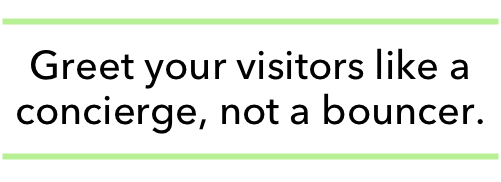
Instead of making it a question about them that makes the user feel you are just trying to get information out of them, make it a question about what kind of solutions they are looking for. For instance, let the user choose whether they want to see your case study about a small-to-medium sized business or a large global enterprise.
In a B2C situation you might give visitors a choice from among categories that will:
- quickly lay out the range of products you offer;
- help them navigate to an appropriate category to start with; and
- help you understand which segment of shoppers they belong to.
Let’s say you are offering gas grills — you could ask whether they are interested in a simple gas grill or an outdoor kitchen. If you have just one product on offer, you might ask the user which use of the product they are most interested in. Whichever they choose first they can always explore the other options later.
It’s tempting to start with an offer on a landing page, and many times an offer is the substance of the pitch in the paid media. However I’ve found that offers in this first moment of a landing tend to drive customers to the wrong product, and so most customers drop out without getting to the right product. Testimonials in this moment can have a similar effect if they push all your inbound prospects towards a particular product model.
Offers work well at the top of the funnel and towards the bottom when you want to seal the deal. In this middle stage, I feel offers are a troublesome distraction from the prospect’s main task of understanding the product or service.

Continue the story from the campaign to the landing page.
How often do you click on an ad for one product only to have it send you to a different product? Or click on an ad only to have it land you somewhere that has nothing to do with the content of the ad, but only the product? These misfires happen far more frequently than they should.
BLANK
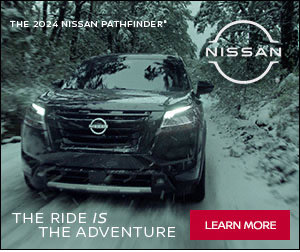 Here’s an ad for the Nissan Pathfinder I clicked through that landed me on the Nissan Rogue.
Here’s an ad for the Nissan Pathfinder I clicked through that landed me on the Nissan Rogue.
BLANK
BLANK
BLANK
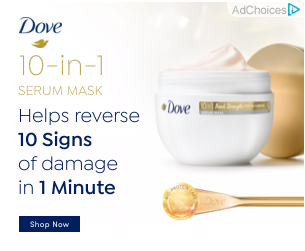
And here’s a Dove ad that starts a story with a product claim that piques interest, then routes you to a product page that does not deliver on that interest.
BLANK
The claim in the ad creates questions — what are the 10 signs of aging it helps with? How does it work? The product page fails to answer these questions in a satisfactory way. (Never mind that the ad appeared next to an article in People Magazine about people in Zanzibar getting sick and dying from eating Sea Turtle meat.)
When there is a narrative or creative connection between an ad and its destination, the visitor has a path to follow that encourages them to stay and engage. Even just making sure the artwork and type is consistent can help create a bridge of trust for the visitor. It is subtle, but the typefaces in the Dove ad, on the product packaging and on the product page don’t match.
When the landing experience doesn’t match the expectations set by the ad, it will be jarring, and the visitor may think there was a error and they landed in the wrong place. A disjointed experience will drive up bounce rates.

Give the visitor real value before you ask them to give you information of value.
When the first thing a landing experience asks for is personal information, it is failing to warm the inbound lead to be willing to share anything. Similarly, hitting the prospect with a pop-up to gather their email address is likely a distraction from the main task they are here to accomplish.
If you are offering a white paper, that’s an opportunity to help leads self-qualify. Instead of making them give you an email address in order to read the white paper — gathering leads your sales team will consider junk — ask the readers after they have engaged with the whitepaper whether they want more like that. Give them sharing options, too.
When you earn the right to ask for contact information, you will have warmer, readier leads. Yes, you’ll likely get fewer email addresses, but instead of leads sales won’t give a damn about, you get a set of prospects into the first step of their lead-warming process.
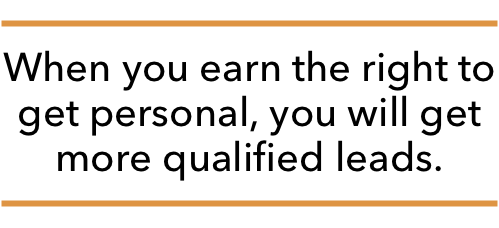
Plus, you will be able to measure which content is more valued by prospects and prompts more and better leads. Then you can stop making the stuff that is useless and focus on the stuff that performs.
In B2C, the analog for the giving-and-getting-value challenge is the frequent desire to get customers into the purchase flow as quickly as possible — to remove any friction for customers with high purchase intent. In my experience, this tactic nearly always backfires and drives most of your other customers away while having little real impact on that narrow 1% to 4% slice of high-intent customers.
The high-intent shoppers are going to get to the purchase flow anyway, and in fact slowing them down slightly, even just to confirm that they are getting the product they really want, helps encourage them to complete the purchase.
For visitors arriving from either paid or organic search, there is a learn moment in their journey it is essential to honor. If you aren’t giving them that opportunity to learn, to understand the product and the offer, you aren’t giving them enough value to ask them to enter the purchase flow.

Coordinate your drivers with your destinations.
Finally, make sure your inbound paid, paid search, and organic search traffic is going to the right destination.
It might seem crazy, but a lot of times the people setting up paid display and paid search advertising don’t bother to make sure the web page they point the ads at is the correct or best place to land the traffic they buy. They may not even notify the owners of the pages that they sending them traffic, or even share any of the campaign creative.
I recall one instance in which paid marketing decided to point ads at a support page for a product because they mistakenly assumed it was the product page. These breakdowns happen more often than you might think.
Simply keeping regular communication between the paid marketing team and owners of product, category and landing pages can pay dividends.
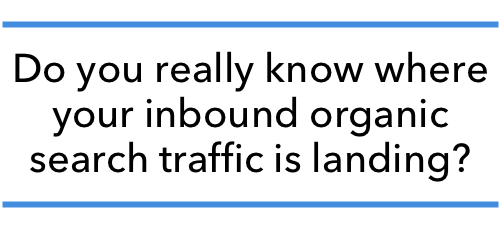
You need to pay regular attention to the pages that are live in your digital customer experience to make sure you don’t have outdated destination pages that pull in — and waste — traffic from Google search.
True story: once in a content audit, I discovered my client had an old microsite that was attracting nearly 30,000 prospects a month from Google. The microsite looked fine until you went to the sign-up page, which was totally broken. That traffic should have been going to a landing experience on their main site that replaced the microsite two years before. When they put a redirect in place and retired the old site, traffic to the correct page doubled. No, I didn’t get a commission.
Common sense, not so common
As I write these observations down, I almost can’t believe I have to. These ideas seem obvious, don’t they?
Keep it simple. Be consistent and trustworthy. Provide meaningful value. Straightforward and timeless marketing principles that, when neglected, undercut the effectiveness of our marketing efforts.
There are many factors to bounce rates, and the rates vary by product and business category, but time and again I have seen convincing data that show paying attention to these details has a real and meaningful impact. We do not need to accept or get accustomed to the high rates of failure that seem to be the norm.

